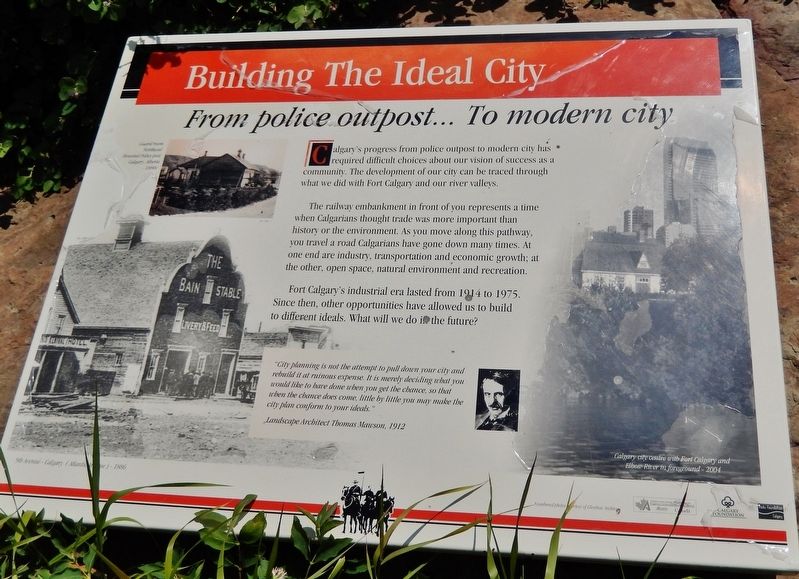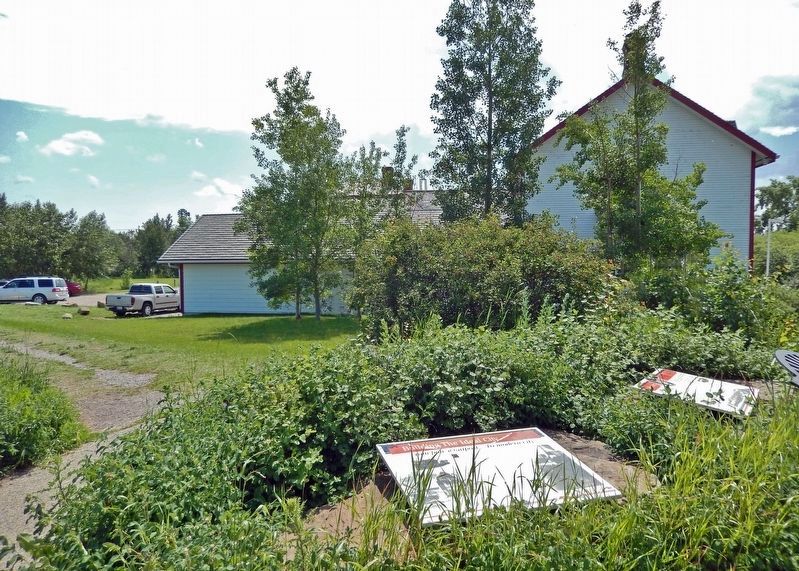East Village in Calgary in Calgary Metropolitan Region, Alberta — Canada’s Prairie Region (North America)
Building The Ideal City
From police outpost... To modern city
Calgary’s progress from police outpost to modern city has required difficult choices about our vision of success as a community. The development of our city can be traced through what we did with Fort Calgary and our river valleys.
The railway embankment in front of you represents a time when Calgarians thought trade was more important than history or the environment. As you move along this pathway, you travel a road Calgarians have gone down many times. At one end are industry, transportation and economic growth; at the other, open space, natural environment and recreation.
Fort Calgary's industrial era lasted from 1914 to 1975. Since then, other opportunities have allowed us to build to different ideals. What will we do in the future?
"City planning is not the attempt to pull down your city and rebuild it at ruinous expense. It is merely deciding what you would like to have done when you get the chance, so that when the chance does come, little by little you may make the city plan conform to your ideals."
—Landscape Architect Thomas Mawson, 1912
[photo captions]
• Guard room, Northwest Mounted Police Post, Calgary, Alberta – 1880s
• 9th Avenue – Calgary (Atlantic Avenue) – 1886
• Thomas Mawson
• Calgary city centre with Fort Calgary and Elbow River in foreground – 2004
Topics. This historical marker is listed in these topic lists: Architecture • Environment • Industry & Commerce • Railroads & Streetcars. A significant historical year for this entry is 1914.
Location. 51° 2.725′ N, 114° 2.694′ W. Marker is in Calgary, Alberta, in Calgary Metropolitan Region. It is in East Village. Marker can be reached from 9 Avenue Southeast, 0.3 kilometers east of 6 Street Southeast, on the left when traveling east. Marker is located along the interpretive trail at Fort Calgary National Historic Site. Touch for map. Marker is at or near this postal address: 750 9 Avenue Southeast, Calgary AB T2G 5E1, Canada. Touch for directions.
Other nearby markers. At least 8 other markers are within walking distance of this marker. Fort Calgary's Railway Era (here, next to this marker); John Ayer (here, next to this marker); Connections (within shouting distance of this marker); Calgarians Rediscover Fort Calgary (within shouting distance of this marker); Wars, Depression and Oil (within shouting distance of this marker); The City of Calgary (within shouting distance of this marker); The Frontier Community Disappears (within shouting distance of this marker); The Mounties Sell Calgary Barracks (within shouting distance of this marker). Touch for a list and map of all markers in Calgary.
Related markers. Click here for a list of markers that are related to this marker.
Fort Calgary National Historic Site
Also see . . . Calgary History.
Calgary's economic growth was closely associated with the development of the ranching industry, and with the city's focal position as the chief transportation centre in Alberta. Before 1906 the open-range cattle industry was the dominant economic activity. The opening of southern Alberta to cash crop farming in the early 1900s brought rapid growth in Calgary, which increased its population by more than 1,000 per cent from 1901 to 1911. A third and crucial element in Calgary's economic development was the emergence of the oil and natural gas industries. Beginning with the first strike in 1914 at Turner Valley, local entrepreneurs, such as William S. Herron, Archibald W. Dingman, and Robert A. Brown, continually promoted Calgary's future as a major oil centre. Calgary was the fastest-growing city in Canada between 2006 and 2011. Its growth is due in large part to the continued prominence of the oil and gas sector as well as an increasingly diversified economic base.(Submitted on May 5, 2023, by Cosmos Mariner of Cape Canaveral, Florida.)
Credits. This page was last revised on May 5, 2023. It was originally submitted on May 4, 2023, by Cosmos Mariner of Cape Canaveral, Florida. This page has been viewed 37 times since then and 7 times this year. Photos: 1, 2. submitted on May 5, 2023, by Cosmos Mariner of Cape Canaveral, Florida.

